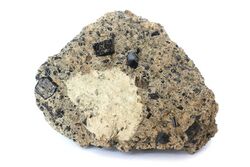Chemistry:Kaersutite
From HandWiki
Short description: Calcic titanium bearing amphibole mineral
| Kaersutite | |
|---|---|
 Kaersutite (black) in tuff. Locality: Suletice, Czech Republic | |
| General | |
| Category | Inosilicate |
| Formula (repeating unit) | NaCa2(Mg3Ti4+Al)(Si6Al2)O22(O)2 |
| Strunz classification | 9.DE.10 |
| Dana classification | 66.01.03a.18 |
| Crystal system | Monoclinic |
| Crystal class | Prismatic (2/m) (same H-M symbol) |
| Space group | C2/m |
| Identification | |
| Color | Dark brown to black, yellow-brown, green-brown, or red-brown in thin section |
| Crystal habit | Prismatic phenocrysts, granular aggregates |
| Twinning | Simple or multiple twinning parallel to {100} |
| Cleavage | Perfect on {110}, intersecting at 56° and 124° |
| Tenacity | Brittle |
| Mohs scale hardness | 5–6 |
| |re|er}} | Vitreous |
| Streak | Pale brownish-grey |
| Diaphaneity | Semitransparent |
| Specific gravity | 3.20 - 3.28 |
| Optical properties | Biaxial (−) |
| Refractive index | nα = 1.670 – 1.689 nβ = 1.690 – 1.741 nγ = 1.700 – 1.772 |
| Birefringence | δ = 0.030 – 0.083 |
| Pleochroism | Strong; X = yellow, yellow-brown; Y = red, red-brown; Z = deep brown, dark red-brown. |
| 2V angle | 66–82° |
| References | [1][2][3][4] |
Kaersutite is a dark brown to black double chain calcic titanium bearing amphibole mineral with formula: NaCa2(Mg3Ti4+Al)(Si6Al2)O22(O)2.[6]
Ferro-kaersutite is the divalent iron rich endmember of the kaersutite group, with the iron replacing magnesium in the structure.[7]
It occurs as phenocrysts in alkalic volcanic rocks; in nodules of peridotite and gabbro in alkalic basalts; in syenites, monzonites and carbonatite tuffs. Mineral association includes titanian augite, rhoenite, olivine, ilmenite, spinel, plagioclase and titanian pargasite.[1]
It was first described in 1884 and is named for Qaersut (formerly Kaersut), Umanq district in northern Greenland.[2]
References
- ↑ 1.0 1.1 http://rruff.geo.arizona.edu/doclib/hom/kaersutite.pdf Handbook of Mineralogy
- ↑ 2.0 2.1 http://www.mindat.org/min-2129.html Mindat: Kaersutite
- ↑ http://www.webmineral.com/data/Kaersutite.shtml Webmineral data
- ↑ "IMA Master List". http://pubsites.uws.edu.au/ima-cnmnc/.
- ↑ Warr, L.N. (2021). "IMA–CNMNC approved mineral symbols". Mineralogical Magazine 85 (3): 291–320. doi:10.1180/mgm.2021.43. Bibcode: 2021MinM...85..291W.
- ↑ http://www.minsocam.org/msa/ammin/toc/Abstracts/2012_Abstracts/ND12_Abstracts/Hawthorne_p2031_12.pdf
- ↑ Ferro-kaersutite on Mindat
 |

